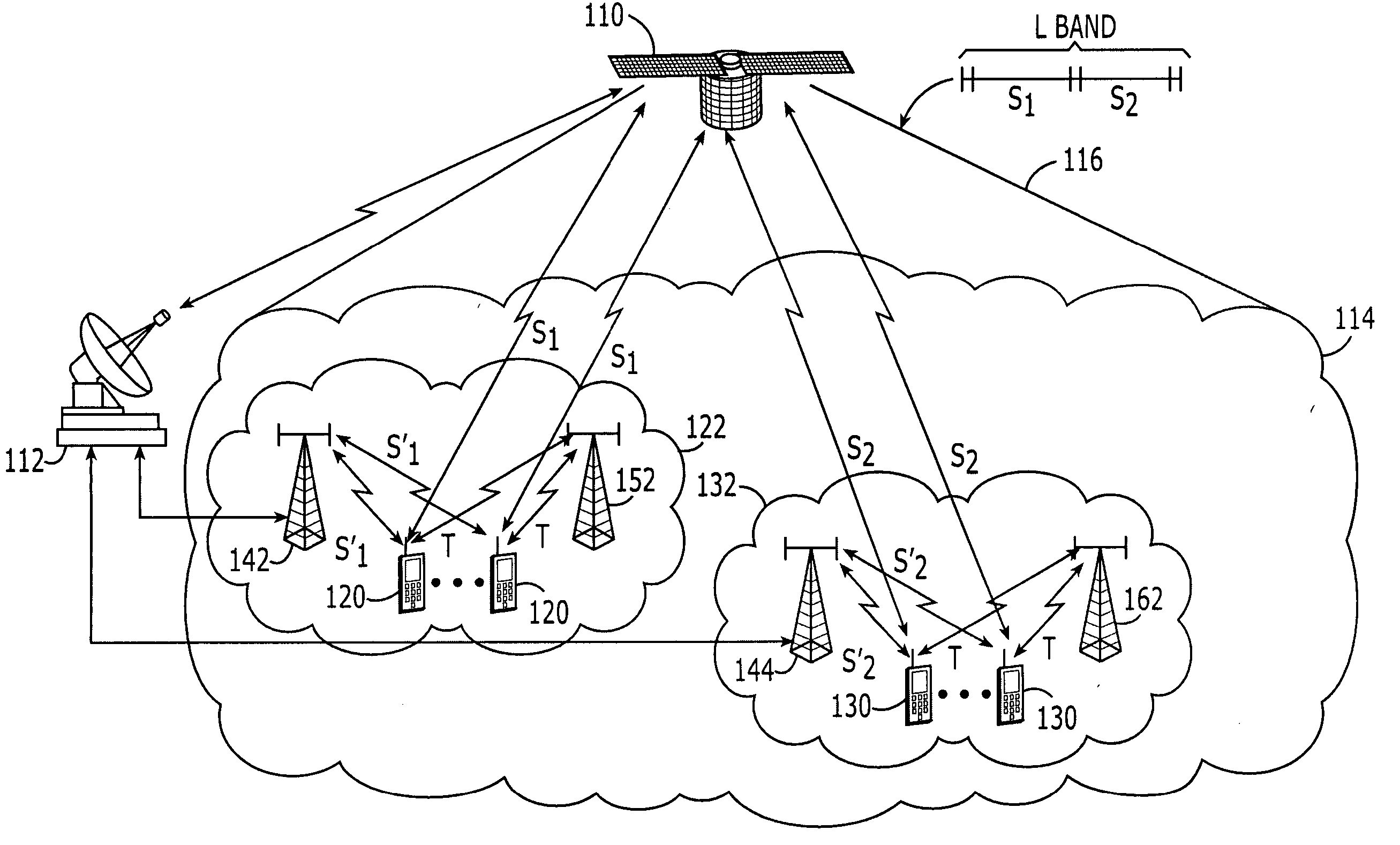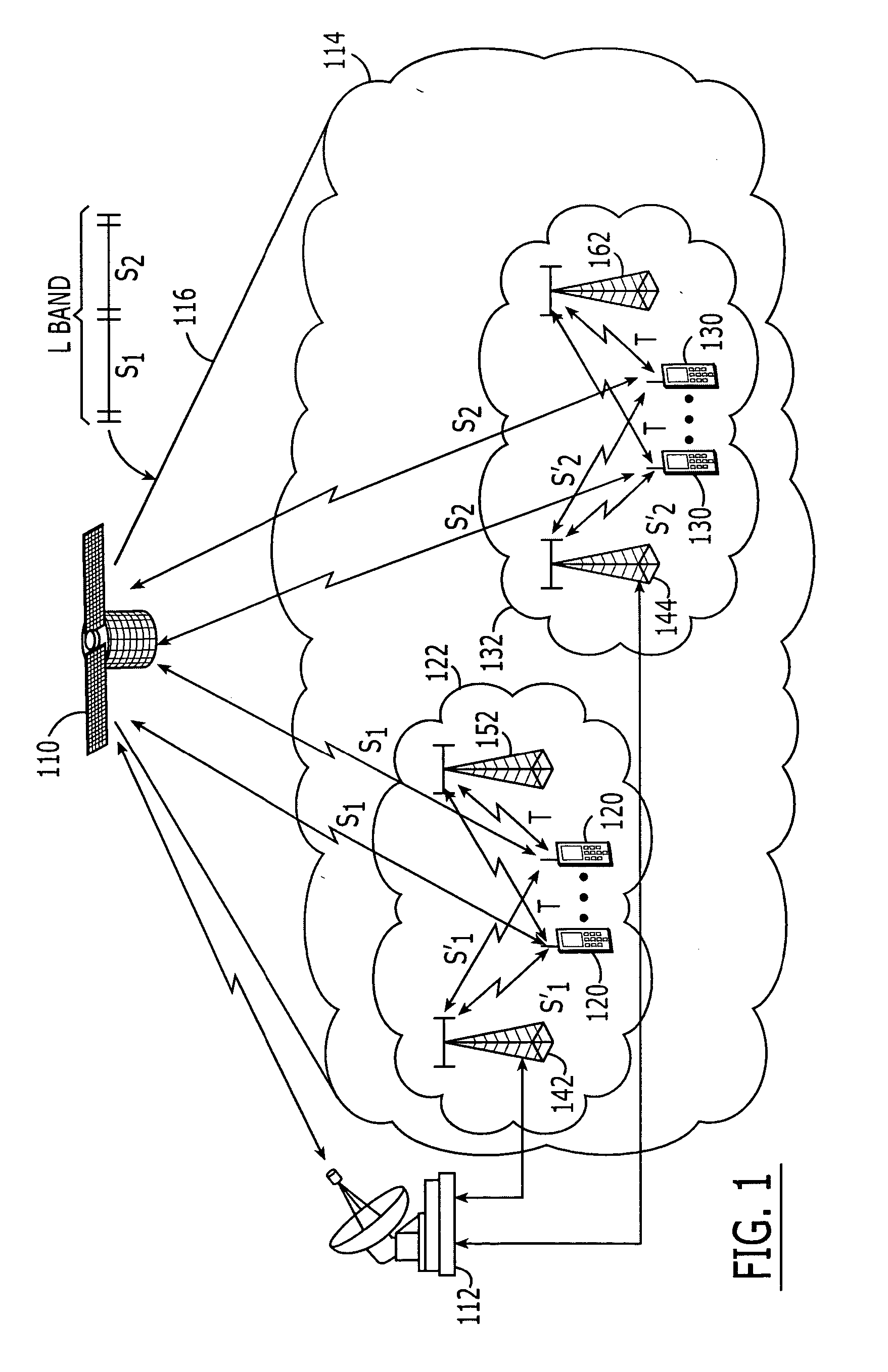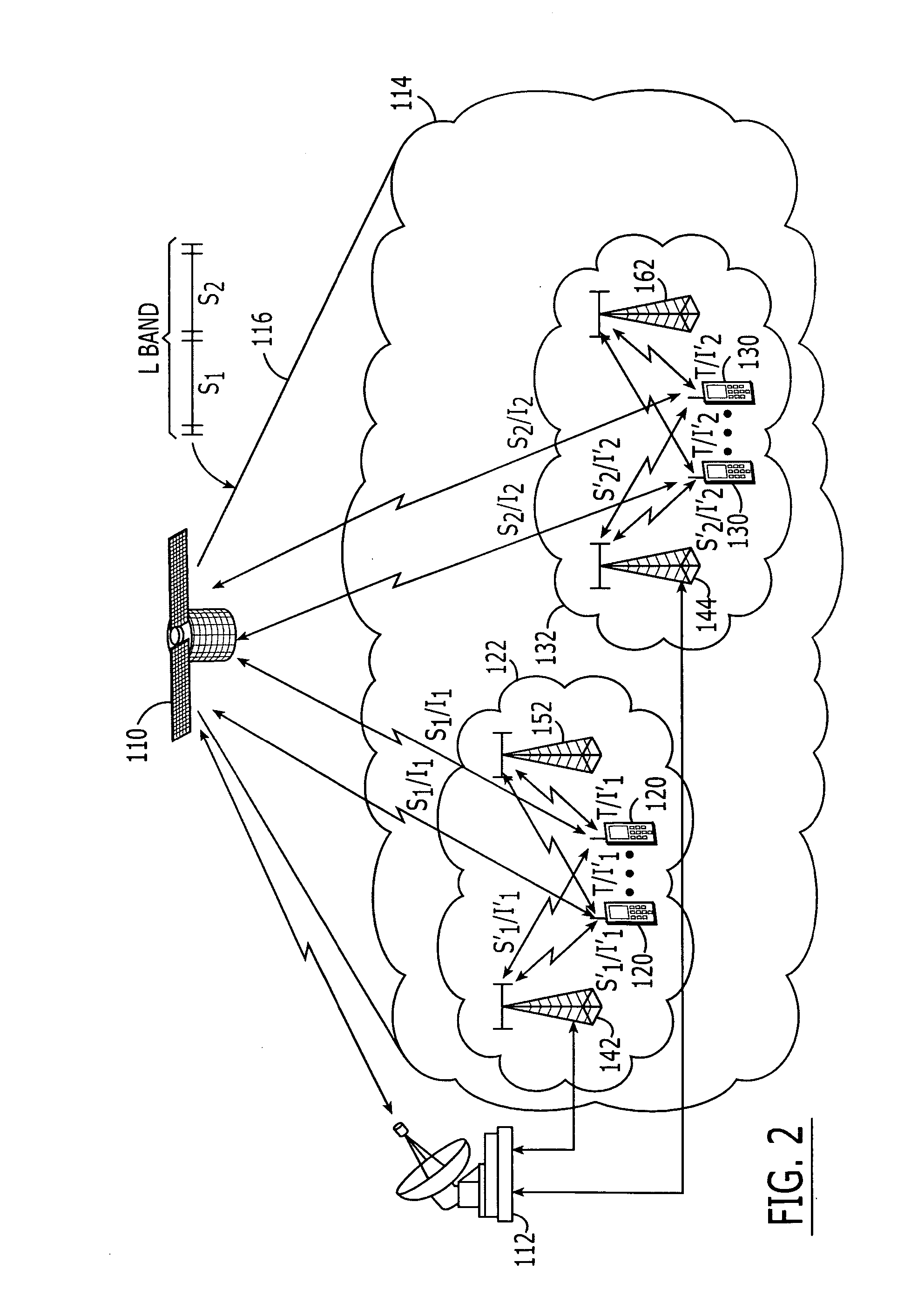[0012] Finally, U.S. Pat. No. 5,073,900 to Mallinckrodt entitled Integrated Cellular
Communications System provides a cellular
communications system having both surface and satellite nodes which are fully integrated for providing service over large areas. A
spread spectrum system is used with
code division multiple access (CDMA) employing
forward error correction coding (FECC) to enhance the effective
gain and selectivity of the
system. Multiple beam, relatively high
gain antennas are disposed in the satellite nodes to establish the satellite cells, and by
coupling the extra
gain obtained with FECC to the high gain satellite node antennas, enough gain is created in the satellite part of the system such that a user need only use a small, mobile
handset with a non-
directional antenna for communications with both ground nodes and satellite nodes. User position information is also available. A
digital data interleaving feature reduces
fading. As also noted in Column 6, lines 1-12 of this patent, a significant
advantage of the invention is that by the use of
spread spectrum multiple access, adjacent cells are not required to use different frequency bands. All ground-user links utilize the same two frequency sub-bands (OG 28, IG 34) and all satellite-user links use the same two frequency sub-bands (OS 30, IS 36). This obviates an otherwise complex and restrictive
frequency coordination problem of ensuring that frequencies are not reused within cells closer than some
minimum distance to one another (as in the FM approach), and yet provides for a hierarchical set of
cell sizes to accommodate areas of significantly different subscriber densities.
[0013] Some embodiments of the present invention provide satellite radioterminal communications systems, methods and components thereof, that can use combinations and subcombinations of multiple band segments of at least one satellite frequency band, multiple air interfaces, multiple spectral reuse cluster sizes and multiple geographic
cell sizes. More specifically, satellite radioterminal communications systems according to some embodiments of the present invention include a space-based component that is configured to communicate with a plurality of first radioterminals in a plurality of first satellite cells over a first band segment of a satellite frequency band, such as a first band segment of satellite L-band, and to communicate with a plurality of second radioterminals in a plurality of second satellite cells over a second band segment of the same and / or different satellite frequency band. In other embodiments, the space-based component is further configured to communicate with the plurality of first radioterminals in the first plurality of satellite cells over a first air interface and to communicate with the plurality of second radioterminals in the plurality of second satellite cells over a second air interface. In still other embodiments, the space-based component is further configured to communicate with the plurality of first radioterminals in the plurality of first satellite cells using a first spectrum reuse
cluster size and to communicate with the plurality of second radioterminals in the plurality of second satellite cells using a second spectrum reuse
cluster size. In yet other embodiments, the space-based component is further configured to communicate with the plurality of first radioterminals in the plurality of first satellite cells having a first geographic
cell size and to communicate with the plurality of second radioterminals in the plurality of second satellite cells having a second geographic
cell size.
[0014] In other embodiments of the present invention, an ancillary terrestrial network is provided that is configured to communicate terrestrially with at least some of the plurality of first radioterminals over substantially the first band segment of the satellite frequency band. The ancillary terrestrial network may be further configured to communicate terrestrially with at least some of the plurality of first radioterminals over substantially the first air interface. The ancillary terrestrial network may be further configured to communicate terrestrially with at least some of the plurality of first radioterminals in a plurality of first ancillary terrestrial network cells using a third spectrum reuse
cluster size. In yet other embodiments, the ancillary terrestrial network is also configured to communicate terrestrially with at least some of the plurality of second radioterminals in a plurality of
second ancillary terrestrial network cells using a fourth spectrum reuse cluster size.
[0015] In any of the above-described embodiments, the plurality of first satellite cells and the plurality of second satellite cells may at least partially overlap geographically. Moreover, in any of the above-described embodiments, either the first spectrum reuse cluster size or the second spectrum reuse cluster size may be equal to one. Moreover, in any of the above-described embodiments, either the first spectrum reuse cluster size or the third spectrum reuse cluster size may be equal to one, and either the second spectrum reuse cluster size or the fourth spectrum reuse cluster size may be equal to one. Additionally, in any of the above-described embodiments, the first band segment of the satellite frequency band and the second band segment of the same and / or different satellite frequency band may overlap partially but not fully. Finally, in any of the above embodiments, the plurality of first satellite cells and the plurality of second satellite cells, and corresponding portions of the ancillary terrestrial network, may be associated with respective first and second
wireless network operators.
[0016] Embodiments of the present invention may be combined with a first terrestrial
wireless network that is configured to communicate terrestrially with at least some of the plurality of first radioterminals over a terrestrial
wireless network frequency band. Moreover, in other embodiments, the terrestrial
cellular network is configured to communicate terrestrially with at least some of the plurality of first radioterminals over substantially the first air interface. Embodiments of the present invention also may be combined with a second terrestrial
wireless network that is configured to communicate terrestrially with at least some of the plurality of second radioterminals over a terrestrial
wireless network frequency band. Moreover, in other embodiments, the second terrestrial
wireless network is configured to communicate terrestrially with at least some of the plurality of second radioterminals over substantially the second air interface.
[0017] Accordingly, some embodiments of the present invention allow a satellite
radiotelephone communications system to provide space-based and terrestrial communications systems using satellite frequencies, for operation with multiple terrestrial cellular radioterminal communications systems. Embodiments of the present invention may also allow an existing satellite radioterminal communications system to be expanded to operate with multiple different terrestrial
wireless systems.
 Login to View More
Login to View More  Login to View More
Login to View More 


